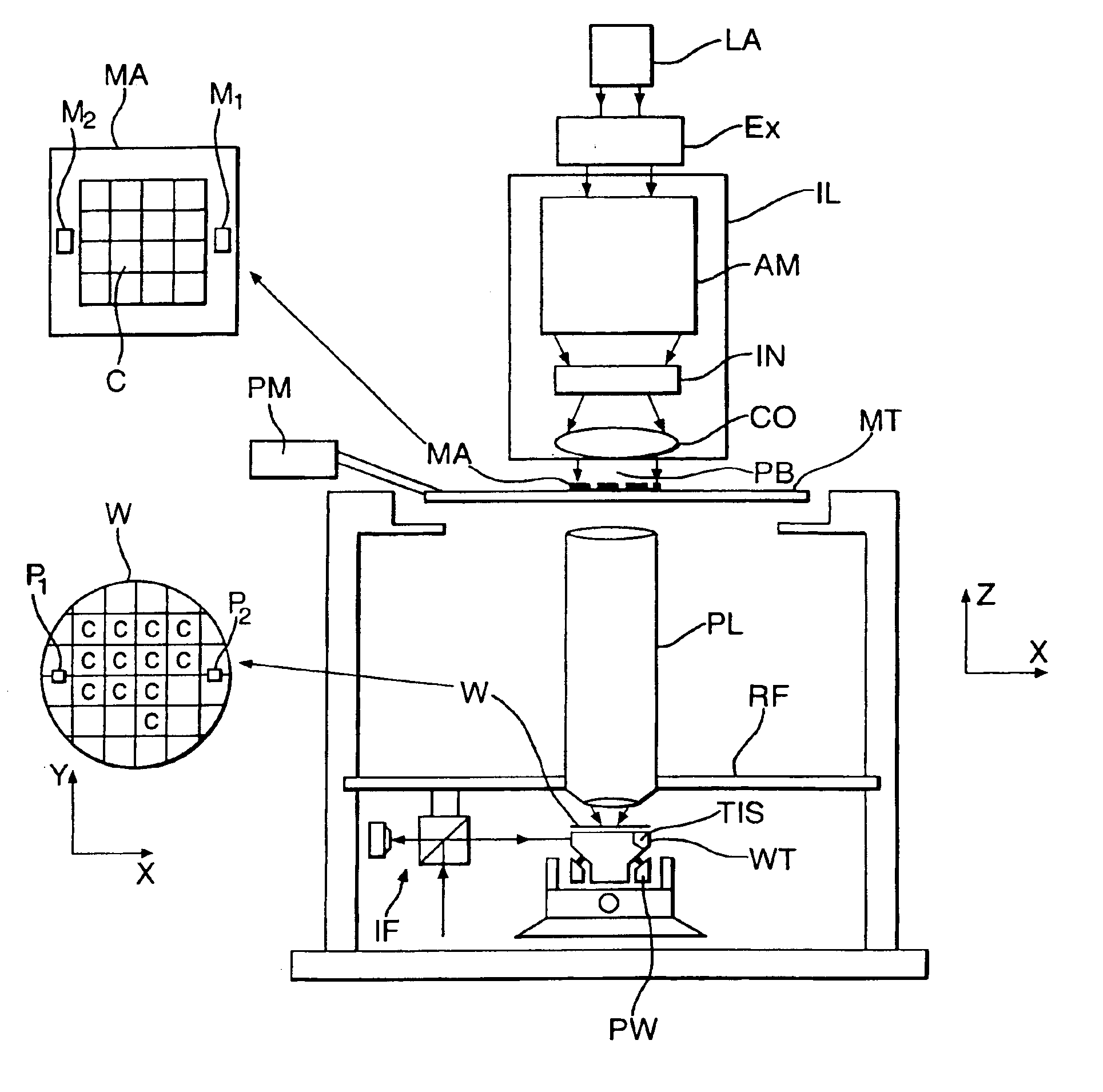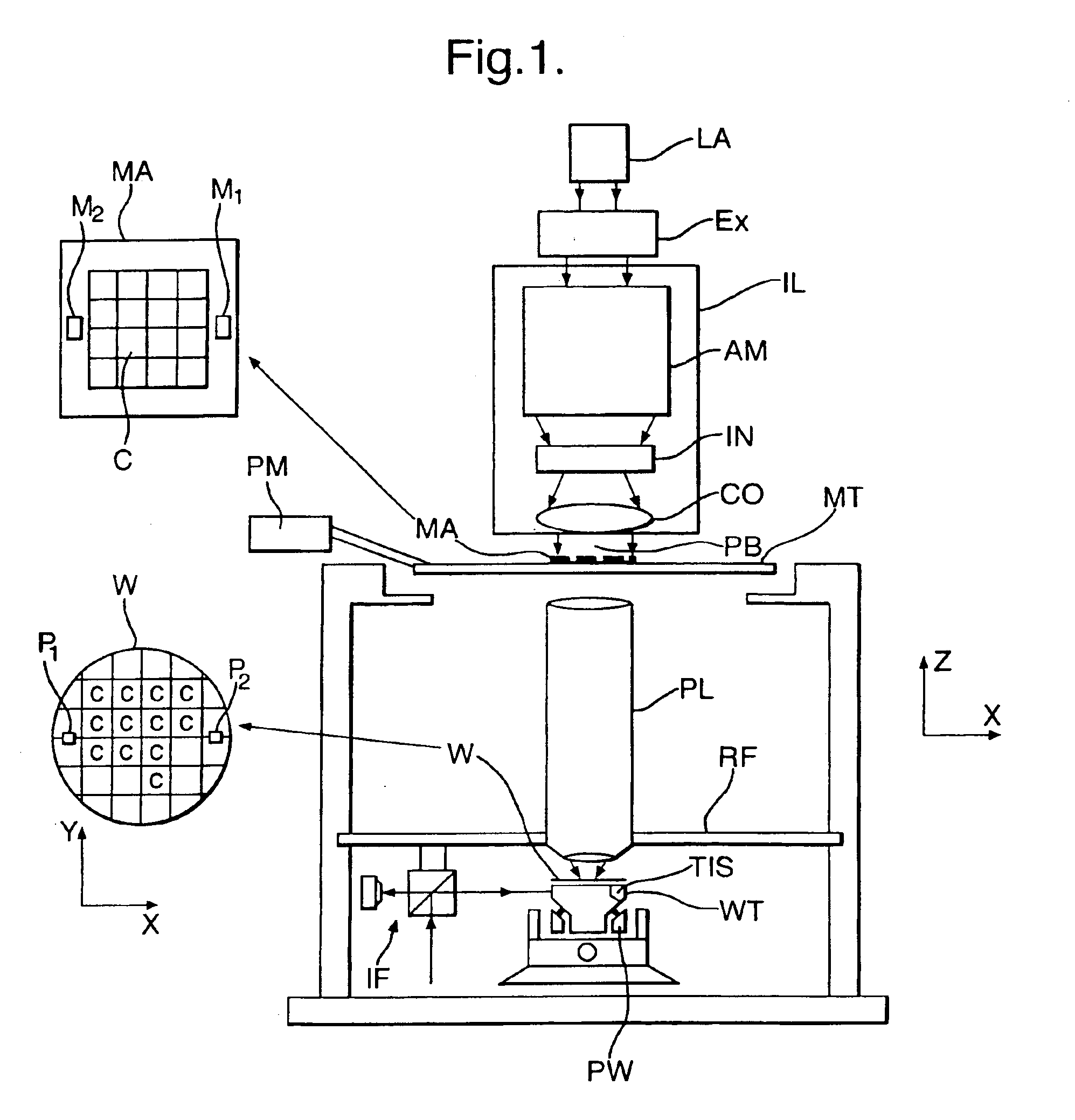Method of determining stray radiation lithographic projection apparatus
a technology of lithographic projection apparatus and radiation detection, which is applied in the direction of electrical apparatus, instruments, printing, etc., can solve the problems of stray radiation, small process latitude, and less resolution, and achieve the effect of increasing the sensitivity of measurement and inherent accuracy of positioning means
- Summary
- Abstract
- Description
- Claims
- Application Information
AI Technical Summary
Benefits of technology
Problems solved by technology
Method used
Image
Examples
embodiment 1
FIG. 1 schematically depicts a lithographic projection apparatus according to a particular embodiment of the invention. The apparatus comprises:a radiation system Ex, IL: for supplying a projection beam PB of radiation (e.g. UV radiation such as for example generated by an excimer laser operating at a wavelength of 248 nm, 193 nm or 157 nm, or by a laser-fired plasma source operating at 13.6 nm). In this particular case, the radiation system also comprises a radiation source LA;a first object table (mask table) MT: provided with a mask holder for holding a mask MA (e.g. a reticle), and connected to first positioning means PM for accurately positioning the mask with respect to item PL;a second object table (substrate table) WT: provided with a substrate holder for holding a substrate W (e.g. a resist-coated silicon wafer), and connected to second positioning means PW for accurately positioning the substrate with respect to item PL; anda projection system (“lens”) PL: (e.g. a quartz a...
embodiment 2
In an embodiment of the invention the test pattern comprises a series 70 of square, opaque isolated areas 10, with sides 20 of increasing length, as shown in FIG. 5. In this figure a series of three isolated areas is shown, which may for example be embodied to have a side length of respectively 160 μm, 252 μm, and 400 μm.
According to the first embodiment, stray radiation coefficients Co1, Co2 and Co3 representative, in a first approximation, for stray radiation in the ranges R1=[6 μm, infinity], R2=[17.5 μm, infinity], and R3=[36 μm, infinity] can be determined. Preferably, the test pattern comprises a plurality of series 70 at a corresponding plurality of positions in the field of the projection system, so that an assessment of the stray radiation condition of the projection system for different field positions can be made. Using the positioning means of the alignment system to subsequently position the detector aperture of the TIS at measurement positions 60 and 61, as defined wit...
embodiment 3
This embodiment is similar to the first embodiment, except as indicated below. In this embodiment, the area 10 is transmissive, and the area 11 is opaque. Also, the test pattern comprises a transmissive area of sufficient size to enable a reference measurement of the projection beam radiation intensity in the absence of effects due to opaque areas. In this area, the detected signal is S2, as described in the first embodiment. The detected radiation intensity I2 in this area is the sum of a notional intensity I21 which would be present in the absence of stray radiation, and a contribution Isr due to stray radiation in a range Rref=[0 μm, infinity]: this contribution Isr is denoted as Isr2[0 μm, infinity] and I2=I21+Isr2[0 μm, infinity].
Similarly, in position 60, the detected radiation intensity I1 (provided as a signal S1) is the sum of said notional intensity I21 and a contribution Isr1[0 μm, (½)×(SI−SD) μm] due to stray radiation in the range R1=[0, (½)×(SI−SD) μm] and
I1=I21+Isr1[0...
PUM
 Login to View More
Login to View More Abstract
Description
Claims
Application Information
 Login to View More
Login to View More - R&D
- Intellectual Property
- Life Sciences
- Materials
- Tech Scout
- Unparalleled Data Quality
- Higher Quality Content
- 60% Fewer Hallucinations
Browse by: Latest US Patents, China's latest patents, Technical Efficacy Thesaurus, Application Domain, Technology Topic, Popular Technical Reports.
© 2025 PatSnap. All rights reserved.Legal|Privacy policy|Modern Slavery Act Transparency Statement|Sitemap|About US| Contact US: help@patsnap.com



